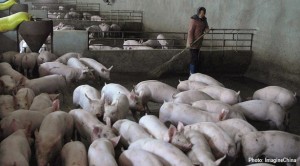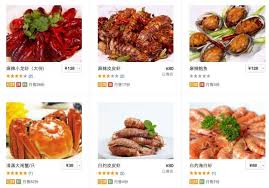Antibiotic resistance is a worldwide health risk, but the influence of animal agriculture on the genetic context and enrichment of individual antibiotic resistance alleles remains unclear.

^
Using quantitative PCR followed by amplicon sequencing, we quantified and sequenced 44 genes related to antibiotic resistance, mobile genetic elements, and bacterial phylogeny in microbiomes from U.S. laboratory swine and from swine farms from three Chinese regions.
We identified highly abundant resistance clusters: groups of resistance and mobile genetic element alleles that cooccur. For example, the abundance of genes conferring resistance to six classes of antibiotics together with class 1 integrase and the abundance of IS6100-type transposons in three Chinese regions are directly correlated. These resistance cluster genes likely colocalize in microbial genomes in the farms. Resistance cluster alleles were dramatically enriched (up to 1 to 10% as abundant as 16S rRNA) and indicate that multidrug-resistant bacteria are likely the norm rather than an exception in these communities. This enrichment largely occurred independently of phylogenetic composition; thus, resistance clusters are likely present in many bacterial taxa.
Furthermore, resistance clusters contain resistance genes that confer resistance to antibiotics independently of their particular use on the farms. Selection for these clusters is likely due to the use of only a subset of the broad range of chemicals to which the clusters confer resistance. The scale of animal agriculture and its wastes, the enrichment and horizontal gene transfer potential of the clusters, and the vicinity of large human populations suggest that managing this resistance reservoir is important for minimizing human risk.
Agricultural antibiotic use results in clusters of cooccurring resistance genes that together confer resistance to multiple antibiotics. The use of a single antibiotic could select for an entire suite of resistance genes if they are genetically linked. No links to bacterial membership were observed for these clusters of resistance genes. These findings urge deeper understanding of colocalization of resistance genes and mobile genetic elements in resistance islands and their distribution throughout antibiotic-exposed microbiomes. As governments seek to combat the rise in antibiotic resistance, a balance is sought between ensuring proper animal health and welfare and preserving medically important antibiotics for therapeutic use. Metagenomic and genomic monitoring will be critical to determine if resistance genes can be reduced in animal microbiomes, or if these gene clusters will continue to be coselected by antibiotics not deemed medically important for human health but used for growth promotion or by medically important antibiotics used therapeutically.
Clusters of antibiotic resistance genes enrich together stay together in swine agriculture
Timothy A. Johnsona,b,f, Robert D. Stedtfelda,c, Qiong Wanga, James R. Colea, Syed A. Hashshama,c, Torey Looftf, Yong-Guan Zhud,e, James M. Tiedjea,b
mBio, Volume 7, Number 2, doi: 10.1128/mBio.02214-15
http://mbio.asm.org/content/7/2/e02214-15.abstract?etoc
A review on antimicrobial resistance in agriculture is also available.
In this article, the current knowledge and knowledge gaps in the emergence and spread of antimicrobial resistance (AMR) in livestock and plants and importance in terms of animal and human health are discussed. Some recommendations are provided for generation of the data required in order to develop risk assessments for AMR within agriculture and for risks through the food chain to animals and humans.
Sophie Thannera, David Drissnerb, Fiona Walshc
mBio, Volume 7, Number 2, doi: 10.1128/mBio.02227-1
http://mbio.asm.org/content/7/2/e02227-15.abstract?etoc
 An epidemiological investigation, pathogen detection, and case–control study were performed. Epidemiological data combined with the epidemic curve indicated that this outbreak was a point source type initially, followed by secondary transmission. The first case was identified as most likely the source of the outbreak.
An epidemiological investigation, pathogen detection, and case–control study were performed. Epidemiological data combined with the epidemic curve indicated that this outbreak was a point source type initially, followed by secondary transmission. The first case was identified as most likely the source of the outbreak.








